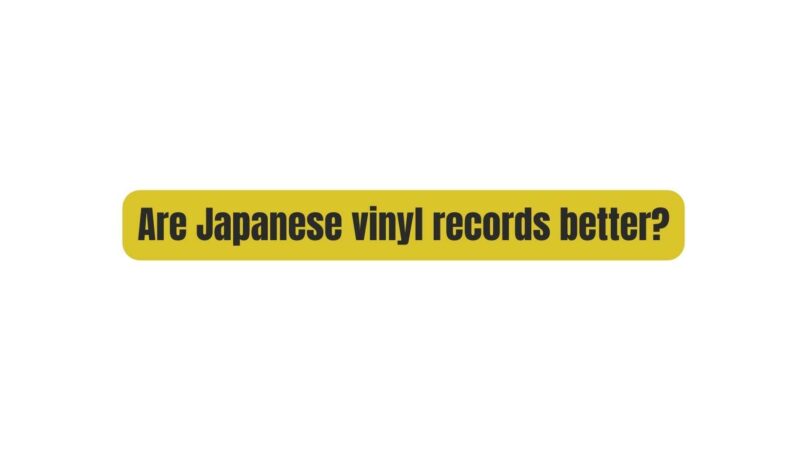In the realm of vinyl records, Japanese pressings have earned a legendary reputation. Audiophiles and music enthusiasts around the world often seek out Japanese vinyl records, believing them to offer superior sound quality, meticulous craftsmanship, and unique collectible value. But are Japanese vinyl records truly better, or is it just a matter of hype and perception? In this comprehensive article, we will explore the fascinating world of Japanese vinyl records, dissecting the reasons behind their popularity, their production processes, and whether they genuinely stand out in the world of analog music.
I. The Allure of Japanese Vinyl Records
Before we delve into the factors that contribute to the perceived quality of Japanese vinyl records, let’s explore why they hold such a special place in the hearts of collectors and audiophiles.
- Impeccable Packaging
- Japanese vinyl records are known for their meticulous packaging, featuring high-quality materials, detailed artwork, and often, additional inserts like lyric sheets and posters. The presentation alone makes them highly sought after.
- Attention to Detail
- Japanese craftsmanship is world-renowned for its precision and attention to detail. This ethos extends to vinyl record production, resulting in records that are perceived to be meticulously made.
- Obi Strips
- An iconic feature of Japanese records is the “obi strip,” a narrow paper band wrapped around the record’s cover. These obi strips often include additional information about the release and contribute to the collectible nature of Japanese pressings.
- Audiophile Quality
- Many collectors and audiophiles claim that Japanese pressings offer superior sound quality, with lower surface noise, better dynamic range, and overall cleaner audio reproduction.
II. The Manufacturing Process
To understand why Japanese vinyl records are perceived as superior, it’s essential to delve into the intricacies of their manufacturing process.
- High-Quality Vinyl
- Japanese records are typically pressed using high-quality vinyl compounds that result in less surface noise and better durability. The use of virgin vinyl, devoid of recycled materials, is a common practice.
- Mastering and Cutting
- Japanese mastering and cutting engineers are renowned for their expertise. They use high-end equipment and techniques to create master lacquers with exceptional audio fidelity.
- Pressing Quality
- The pressing process in Japan is known for its precision. Meticulous quality control ensures that records are free from defects, warps, or irregularities.
- Audiophile Labels
- Some Japanese record labels, such as Mobile Fidelity Sound Lab (MFSL) and Toshiba EMI, are famous for their audiophile releases. These labels prioritize the use of audiophile-grade materials and processes.
III. Collectibility and Rarity
Japanese vinyl records have become sought-after collector’s items due to their limited availability and unique features.
- Limited Editions
- Many Japanese records are released as limited editions, often with unique cover artwork or colored vinyl variants. This exclusivity adds to their allure among collectors.
- Obi Strips
- The obi strips mentioned earlier are collectible in their own right. Some collectors value records with intact obi strips as they are considered more authentic and valuable.
- Japanese-Exclusive Releases
- Some albums and singles were exclusively released in Japan, making them highly sought after by collectors worldwide. These releases often feature bonus tracks or unique mixes.
IV. The Sonic Debate
While Japanese vinyl records enjoy a reputation for superior sound quality, it’s important to recognize that the perceived superiority can be subjective and influenced by various factors.
- Audio Source
- The quality of the audio source, such as the original master tapes, can have a significant impact on the sound quality of a vinyl record. Japanese pressings may excel when sourced from well-maintained masters.
- Playback Equipment
- The playback equipment, including turntables, cartridges, and speakers, plays a crucial role in the perceived sound quality. High-end equipment may reveal nuances in Japanese pressings that lower-end systems might miss.
- Condition and Maintenance
- The condition of the vinyl record and its cleanliness also affect sound quality. Well-preserved Japanese records are more likely to sound superior.
- Personal Preference
- Ultimately, the preference for Japanese vinyl records may come down to individual taste. Some listeners may prefer the warmth and character of vintage pressings, while others may gravitate toward the cleaner sound associated with Japanese pressings.
V. Conclusion
Japanese vinyl records undeniably possess a unique charm and allure, which has contributed to their legendary status among collectors and audiophiles. From their impeccable packaging to meticulous manufacturing processes and collectible value, Japanese pressings have much to offer. However, whether they are objectively “better” is a matter of personal preference, influenced by various factors, including the source material, playback equipment, and individual taste.
For many, Japanese vinyl records represent a commitment to quality, craftsmanship, and a passion for the analog music experience. Whether you’re a seasoned collector or a newcomer to the world of vinyl, exploring Japanese pressings can be a rewarding journey, allowing you to discover the nuances and unique characteristics they bring to your music listening experience. Ultimately, the quest for the perfect vinyl record is a subjective and deeply personal one, and Japanese vinyl records are a captivating chapter in that ongoing pursuit.


